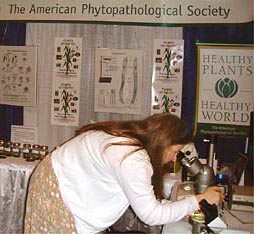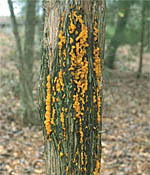By Kisha Shelton,
Plant Pathology Department, University of Georgia
In April (6th-9th, 2000) the American Phytopathological Society (APS) presented several exhibits at the National Convention of the National Science Teachers Association (NSTA) in Orlando, FL. APS exhibitors, Claudia Jasalavich, Richard Raid, Janice Collins, and Cosandra Hochreiter had the opportunity to share plant pathology with educators (kindergarten through university) from the United States, Canada, Europe, and the Carribean. Exhibits were open over a four-day period with approximately 1000 educators and exhibitors visiting the APS booth.
 |
|
Raid and Collins working the booth at NSTA events. |
The APS booth was exhibited as part of the "plant place" with the Wisconsin FastPlants and C-Ferns (American Society of Plant Physiologists). The APS booth, designed and coordinated by Jasalavich, featured two activities, "Water Molds" and "Nematodes." Handouts containing information on how to set up and how to do the activities were provided for teachers to take back to their classrooms. Also featured was the full color "Plants Get Sick, Too!" poster designed by Joseph Esnard. Click the link to download a copy.
 |
|
Jasalavich demonstrates "water molds" activity. |
The English translation of the storybook, "Plant Pathology: Past to Present" and the Spanish translation, "Fitopatología: Del Pasado Al Presente", were handed out to educators. Frank Tainter, the author, had recently updated the storybook to reflect more accurately the uses of genetic engineering and chemical controls being used in agriculture. Rebecca Alvarez Zagoya prepared the Spanish translation while Jose Amador revised the Spanish translation.
The booth was funded by the Office of Public Affairs and Education (OPAE) and the Storybooks were printed with funds from the APS Foundation. The microscopes and a truck were on loan from the Everglades Research and Education Center, University of Florida. APS plans on exhibiting at future NSTA National Conventions.

|
| Views: Unseasonably warm, wet weather in Auburn, Alabama in January, 1999 resulted in the early production of telia of the rust fungus, Gymnosporangium clavipes, on eastern red cedar. G. clavipes infects more than 480 species typically causing perennial cankers which appear as slight swellings on the stem or branches of eastern red cedar. The disease caused by this pathogen is more serious on apple, pear, quince and many other species in the rose family. Courtesy Scott Enebak.
|
